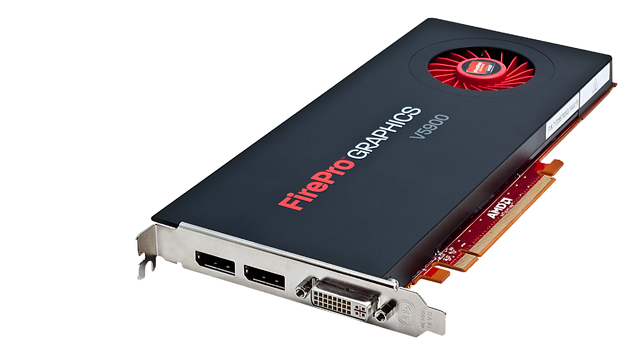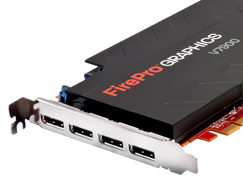This time last year AMD introduced a whole new generation of professional graphics cards and with it some multi-monitor wizardry called Eyefinity. With Eyefinity, the FirePro V4800, V5800, and V7800 became the first professional cards to support three monitors off a single board. This was an exciting proposition for those who use a combination of CAD/CAM/CAE, PDM or office software, or regularly swap between parts, assemblies, drawings and the like.

The AMD FirePro V5900 features 512 stream processors and 2GB GDDR5 memory
Moving up the range, the high-end FirePro V8800 supported four screens and the FirePro V9800 could even power six. This was another first and meant that a single professional graphics card could now drive a high-definition powerwall, something that previously required two or three discrete boards.
AMD is now introducing its second round of FirePro Eyefinity graphics cards, based on its 3rd generation 40nm GPU (formerly codenamed “Cayman”). The initial focus is at the mid-range and high-range of the market with the FirePro V5900 ($599) and FirePro V7900 ($999), but we expect others to follow shortly. Both cards are already available as options in Dell’s Precision workstation range and, come July 1st 2011, HP’s Z Series.
FirePro V5900 (2GB GDDR5)
The FirePro V5900 is AMD’s performance CAD card. It supports up to three monitors through two DisplayPort 1.2 and one dual link DVI outputs, features 512 stream processors and 2GB GDDR5 memory. In relation to current software this is an incredible amount of memory for CAD with most users not needing more than 1GB. Even those with complex datasets in applications such as SolidWorks, Catia and Alias that use Vertex Buffer Objects (VBOs) (an OpenGL extension where geometry is loaded up and resides on the graphics card) are unlikely to get anywhere near the 2GB limit.
Where this additional memory will offer benefits is for users of design visualisation applications such as 3ds Max where heavy use of textures is common. Looking to the future it could also help those looking to take advantage of GPU compute in OpenCL-based rendering or simulation applications which will be coming on stream later this year.
FirePro V7900 (2GB GDDR5)
The FirePro V7900 is AMD’s high-end card for users of design visualization software or CAD applications such as NX and Catia that are able to make use of the additional GPU processing power as they are not so limited by the speed of the CPU.
The card features a whopping 1,280 stream processors and, like the V5900, 2GB GDDR5 memory. It features four DisplayPort 1.2 outputs, which means it can also be used to drive a 2 x 2 powerwall. Other high-end features include support for stereo 3D for use with 3D monitors, projectors or glasses, plus an optional add-on for Genlock / Framelock, where the display output from graphics cards in individual machines can be synchronised for high-performance powerwalls. This is a very high-end feature to have on a $999 card.
3D performance
Naturally, 3D performance is high on the list of priorities with the new cards and here AMD has concentrated heavily both on hardware and software (drivers). The new generation cards feature a tech called GeometryBoost that processes two primitives per clock cycle.
Of course for professional 3D it’s all about making the most out of the available hardware and AMD has also been working extensively with the CAD/CAM/CAE software developers to help boost performance. The FirePro driver team is particularly pleased with its performance increases under SolidWorks, Catia, NX, Maya and Autodesk Inventor, an application whose 3D performance is typically governed by the speed of the CPU. Expect AMD to announce improved performance in other 3D applications soon.
N.B. It should be noted that these driver optimizations should also benefit existing FirePro customers, so it’s worth checking out the latest 8.83.5.3 driver, though this is not yet certified for use with most 3D applications.
Power saving
Electricity usage is big news in workstations at the moment and graphics cards can draw as much power as CPUs, if not more. To put this in perspective the FirePro V7800 draws a maximum of 150W, the V5800 a maximum of 75W, and the Core i7 2600K, Intel’s top-end standard desktop CPU, a maximum of 95W.
Compared to other graphics cards in their class AMD’s figures are not big, but to save energy it has developed a new power management technology called Powertune. According to AMD, it can save as much as 50% when the stream processors are not being put to work on complex 3D datasets.
Video walls
For those not content with support for three and four monitors respectively in the V5900 and V7900, the fact that both cards feature DisplayPort 1.2 is to open things up even further in the future. Due to the increased bandwidth that the 1.2 standard offers, plus some clever clock synching tech, two of the DisplayPorts on the V5900 and V7900 will be able to drive three monitors, meaning a total of six.
In the past we have heard reports of “good 3D performance” from Dassault Systèmes when running six monitors off a single high-end FirePro V9800. Comparing specs like for like we can guess that the V7900 would be able to do a pretty good job here but the V5900 would probably be a little underpowered to deliver the required frame rates. Still, this feature on the V5900 could still be of interest to those wanting to create low-cost video walls rather than a 3D powerwall.
To take advantage of MST you either need DisplayPort 1.2 compatible monitors, which can be daisy chained using two ports, or an MST Hub, which can also support older video standards such as DVI and VGA. Compatible monitors are only out next month and hubs (for those that don’t want to invest in new screens) later this year, so it’s definitely one for the future.
Conclusion
On paper the new cards look like an exciting proposition for CAD. In addition to all the hardware developments it’s great to see AMD working more closely with the software developers to further boost performance under key CAD software applications. It’s also good to know that existing customers will also be able to benefit from these driver optimisations.
We’ll be testing the new cards with SolidWorks 2010 very shortly and will post our findings here.
*********UPDATE: TESTING UNDER SOLIDWORKS 2010***********
We spent all of yesterday testing the FirePro V5900 under SolidWorks 2010 and it delivered some very impressive results, though it’s not good news for all SolidWorks users.
Regular readers of DEVELOP3D will know that getting the maximum 3D performance out of SolidWorks does not always depend on having a powerful graphics card. In many cases the CPU becomes the bottleneck before the GPU even has a chance to get out of first gear. In such circumstances relatively low powered graphics cards can deliver as much 3D performance as high-end graphics cards.
In SolidWorks this all depends on the type of models you create. Our standard test dataset, an assembly of a digital SLR, is not throttled by the speed of the CPU and the more graphics power you throw at it the better the frame rates.
Testing with RealView turned on, the FirePro V5900 excelled, delivering an average frames per second (FPS) of 45, the fastest we’ve ever seen. For comparison we also tested a FirePro V5800 and Nvidia’s Quadro 2000 in the same workstation. This was an InterPro PW-SB [i7] with a Core i7 2600K CPU (overclocked to 4.5GHz), 16GB RAM, 120GB SSD and 2TB SATA hard drives (£1,325).
With the old 8.773.1.2 driver the FirePro V5800 delivered 20 FPS, but this shot up to 34 FPS with the new SolidWorks-optimized 8.83.5.3 driver. The Nvidia Quadro 2000 with a 270.71 driver put in a score of 28 FPS.
We also tested the three cards with another SolidWorks model, a heavy machinery assembly that is known to be CPU limited and the results were very different. The FirePro V5900 produced 14 FPS, the FirePro V5800 13 FPS with the 8.773.1.2 driver and 14 FPS with the 8.83.5.3 driver, and the Nvidia Quadro 2000 16 FPS.
So what does this tell us?
First, it shows that when the FirePro V5900 is given the chance it delivers excellent performance. AMD says this will be the case in applications such as NX and Catia, where the GPU typically becomes the bottleneck before the CPU. On the flip side, it is unlikely to perform better than lower specification cards under CPU limited applications like Inventor, Pro/Engineer (Creo) and, in some circumstances, SolidWorks.
Secondly, it emphasizes the importance of testing with your own datasets. The only way you will know how a card truly performs is when testing your troublesome assemblies in your CAD application of choice.
Thirdly, with reference to the performance boost seen in the FirePro V5800, it shows what can be done with good driver optimization. Creating a powerful piece of hardware is essential, but arguably the bigger challenge when it comes to professional graphics cards is harnessing as much of that power through code that is optimised for specific CAD applications.







